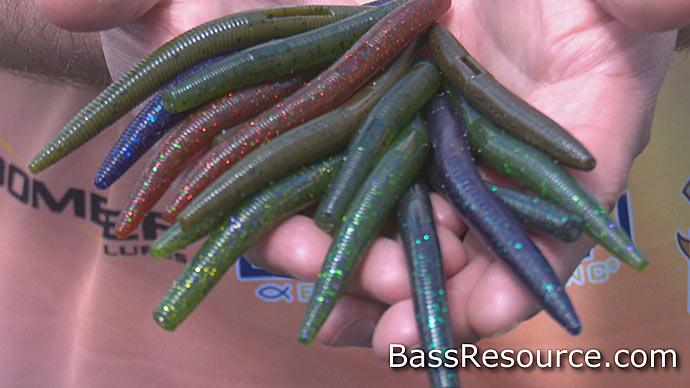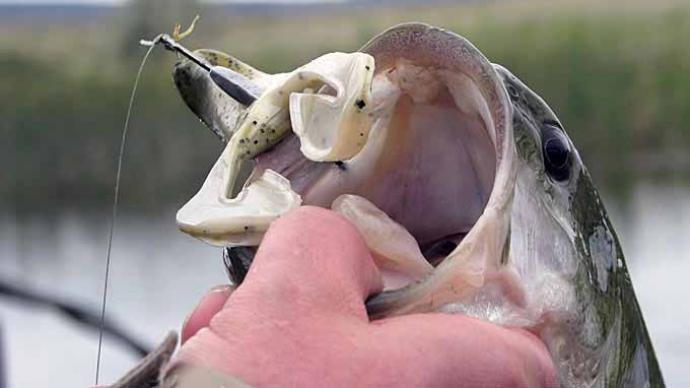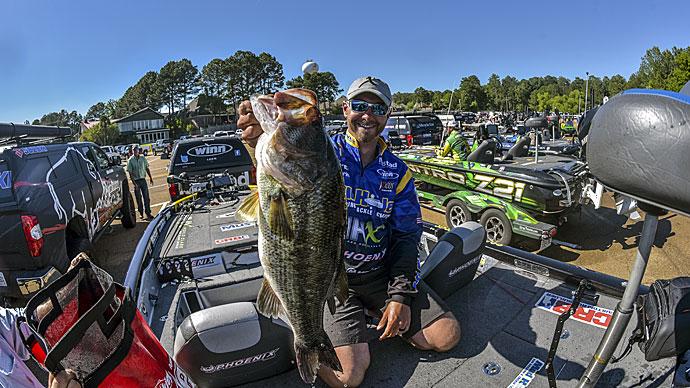![When the water is clear and the weather calm, it’s hard to beat the darting and gliding action of a Texas-rigged soft jerkbait. Take that deeper by rigging it on a jig head. Fish it with big hops to catch smallmouth bored by tubes and drop shots. [PHOTO BY PETE M. ANDERSON]](/files/bass-fishing-img/Five-Soft-Plastics-1.jpg)
Bass lures become favorites because they do one thing well — catch bass. And there are plenty of soft-plastic ones that fall into that category. But even the best fishing lures can be made better with some tweaks.
Some adjustments make a soft-plastic lure more versatile, allowing you to chase bass in more types of cover and at different depths. Others add longevity, so you spend more of your precious time on the water fishing, not rerigging.
Every bass angler packs the following five soft-plastic lures in their tackle box because they consistently work with basic presentations. But make these slight alterations to their rigging, or redeploy them in a different situation, and you’ll catch more and bigger bass.
-
Worms
Worms are the best-known soft-plastic lure. Whether they measure a few stubby inches or a snake-like foot or longer, there’s one for every fishing situation. Every bass angler knows how to rig one. For example, those who regularly fish northern smallmouth waters can build a drop-shot rig with one in their sleep. That should be something that largemouth anglers might want to master, too, even when fishing shallow water.
Bass anglers think drop shots are great for several reasons. First, the weight hangs below the lure. That distance gives your lure the freedom to create action. If you keep a semi-taunt line, your lure stays off the bottom and above the bottom cover, putting it in perfect view of nearby bass. Gently shake your line, and the worm moves while the weight pegs it in one spot indefinitely, calling bass to it.
While a drop shot tied with heavy line, hook, and weight — “Bubba Shot” — is seeing more action in shallow water filled with heavy cover, especially aquatic vegetation, make room near the bank for a more finesse version. Use it to catch bass that are schooling on shallow flats in the back of creeks during the fall. You can catch them haphazardly casting a crankbait or jerkbait. But a well-placed drop shot next to a lone piece of cover, such as a stump, log or rock, or a shallow ledge or steep bank, against which they’ll herd baitfish, shows these often-skittish bass something different. You also can pitch one under a dock or laydown. Working it in place gives bass, especially pressured ones, plenty of time to find your worm in the shade or among the branches.
But to make these shallow-water presentations work, you need to re-rig your drop shot. Make your leader shorter. Casting one 2-feet long, like what’s commonly used in deep water, will only end up in tangles. The weight, for example, may wrap around a brush-pile branch. So, cut that length in about half. That also makes a little action go far, so soften your shakes by limiting rod-tip movement.
There are many reasons to keep casting a Texas-rigged worm. And while it has been around for decades, there is still an opportunity for improvement. That starts with its bullet weight. Lighter ones that freely slide on the line give your worm more action; instead of rocketing to the bottom, they slither their way down.
Choose a heavy enough sinker to cast through the day’s wind, overcome any current and make its way through cover. Pay particular attention to that last point. If it’s too light, you may think your worm is on the bottom, but it’s hung on vegetation, brush, or other cover higher in the water column. Switching to a worm with a straight tail, which won’t wrap around the cover, will help your worm make it to the bottom.
-
Stick worms
Image![Stick worms, which quiver as the sink, excel when they are fished without a weight. Rigging them on a heavy shaky head creates a finesse offering with a large profile that can be presented to bass holding on deep structure. [PHOTO BY PETE M. ANDERSON]](/files/bass-fishing-img/Five-Soft-Plastics-2.jpg)
Stick worms, which quiver as the sink, excel when they are fished without a weight. Rigging them on a heavy shaky head creates a finesse offering with a large profile that can be presented to bass, holding on to deep structure. [PHOTO BY PETE M. ANDERSON] This style of soft-plastic lure, whose poster child is Yamamoto’s Senko, landed on the bass-fishing scene with a giant splash. While its waves are no longer as well documented as at first, stick worms remain potent bass catchers, especially with a few tweaks.
Rig your stick worm wacky style as often as you can. Texas rigging is excellent if the cover is exceptionally thick, but that cuts its action in half. Hook them once through the middle, using a hook with a weed guard if need be, and both of its ends can quiver, and the natural shimmy along its length is preserved.
Securing the hook with an O-ring is a popular tweak, so keep using one. It makes your stick worm last longer — their soft plastic lacks durability — it makes you a more confident caster. That’s important when you must add force to skip it into hard-to-reach spots such as under a pontoon boat. But be mindful of where you place them. They must favor the worm’s thicker end, so the thinner one has more action.
Rig a stick worm on a jig head and take it to deep water, where fewer bass have seen one. Large shaky heads are perfect for this tweak, though use one with a long hook shank. It will help with your hook sets. While you can hop it around sunken brush piles or rocky points with a traditional ball-shaped head, step up your game using a football-shaped one. It’ll wobble as you drag it across the structure, adding natural movements amplified along the stick worm's length, making its tail sway.
-
Swimbaits
Swimbaits’ popularity has accelerated over the past few decades thanks to a big-bass push from the West Coast. They are versatile. You can slow roll them across shallow flats scattered with submerged aquatic vegetation for smallmouth or add extra weight and send them to the deepest structure for summertime largemouth. Jig heads are the most popular rigging option for those scenarios. But you can do more with swimbaits if you Texas rig them.
Texas-rigged swimbaits give you access to heavy cover in shallow water, especially when it’s clear, providing a finesse alternative to popular bladed jigs and spinnerbaits. You can throw them in the middle of the brush, a laydown or bed of vegetation — emergent or submergent — without fear of fouling.
Texas rigs are built around the hook, and swimbaits, like worms, demand one with a straight shank and round bend. You’ll need as much gap as possible to handle its bulk and still stick a bass.
Avoid tying on an extra-wide gap hook because its point is directly behind its line tie. So, while its gap can handle the thickest swimbaits and hold once set, it has to align perfectly to do the latter. You may miss many bass waiting for that to happen.
Match your weight to the action you want your swimbait to create, not water depth or casting distance. You won’t need weight to cast its bulk, so use just enough in the form of a bullet sinker to keep it under the surface and swimming. If you're fishing during early prespawn, try a 1/8-ounce or lighter weight when bass want slow-moving presentations. But if you’re covering water or generating reaction strikes, you’ll fish faster with a 1/4- or 3/8-ounce weight. It’s easier to fine-tune the weight this route instead of using a weighted swimbait hook.
Peg the weight on your line, about an 1/8 inch ahead of your swimbait. That space gives your swimbait more action while keeping your sinker corralled, eliminating the chance of it tangling with cover when it lands after a cast.
-
Soft jerkbaits
Soft jerkbaits, a subtle alternative to noisy hard jerkbaits, help you catch more bass when shallow water is clear and conditions calm. But follow walleye anglers’ lead, and you can use them to catch plenty of deep-water smallmouth, especially those tired of tubes and drop shots.
Ditch the worm hook and possibly a small sinker, and thread your favorite soft jerkbait on a jig head. The combination creates a darting and flashing action while it sinks. So, you’ll want it to spend most of each retrieve doing just that. Don’t be bashful about moving your rod tip: Start with it touching the surface and end with it pointing straight up. If the school is big or slightly suspended, get more drop by lifting your arm above your head.
While traditional round jig heads will work with soft jerkbaits, get more of the gliding action created by their flat sides by using a darter head. Its conical shape sends it in a random direction each time it sinks. And don’t overpower it. You want just enough weight so that you can feel it sinking.
Image![Make your soft-plastic toad a better bass catcher by adding a small bullet weight, which keeps its head down and legs kicking. [PHOTO BY PETE M. ANDERSON]](/files/bass-fishing-img/Five-Soft-Plastics-3.jpg)
Make your soft-plastic toad a better bass catcher by adding a small bullet weight, which keeps its head down and legs kicking. [PHOTO BY PETE M. ANDERSON] -
Toads
Toads, the soft-plastic lures with twin kicking tails, such as Zoom’s Horney Toad, come in a wide selection of colors and a handful of sizes. They cast well, can be rigged weedless, and create the types of topwater blowups that all anglers love.
The most popular rigging for toads is Texas-style. It keeps them from catching cover, an important factor whether you’re casting into matted aquatic vegetation, laydowns, or around docks. If the cover isn’t too thick, you can switch to Tex-posed, where the hook’s point is pushed through the plastic, and the tip tucked back in. There are a couple of ways to make them even better.
If you’re fishing your toad on heavy monofilament or fluorocarbon line — 15- to 25-pound test — leave a slightly longer than usual tag on your knot, about 3/16 of an inch. Push your toad over it, and it will act as a keeper, helping to lock your lure on the hook. It’ll do an even better job if you add a drop of super glue.
Slide a light-weight bullet weight — about 1/16 ounce — onto the line before you tie on your hook. Your toad will ride slightly lower in the water, ensuring more water reaches its legs, keeping them kicking. It also makes it easier for bass to grab your toad. Use a weight made from tungsten, almost twice as dense as lead. While it will weigh the same as a lead weight, it’ll be much smaller, making it less likely to grab vegetation as your toad skims along the surface.
BassResource may receive a portion of revenues if you make a purchase using a link above.




